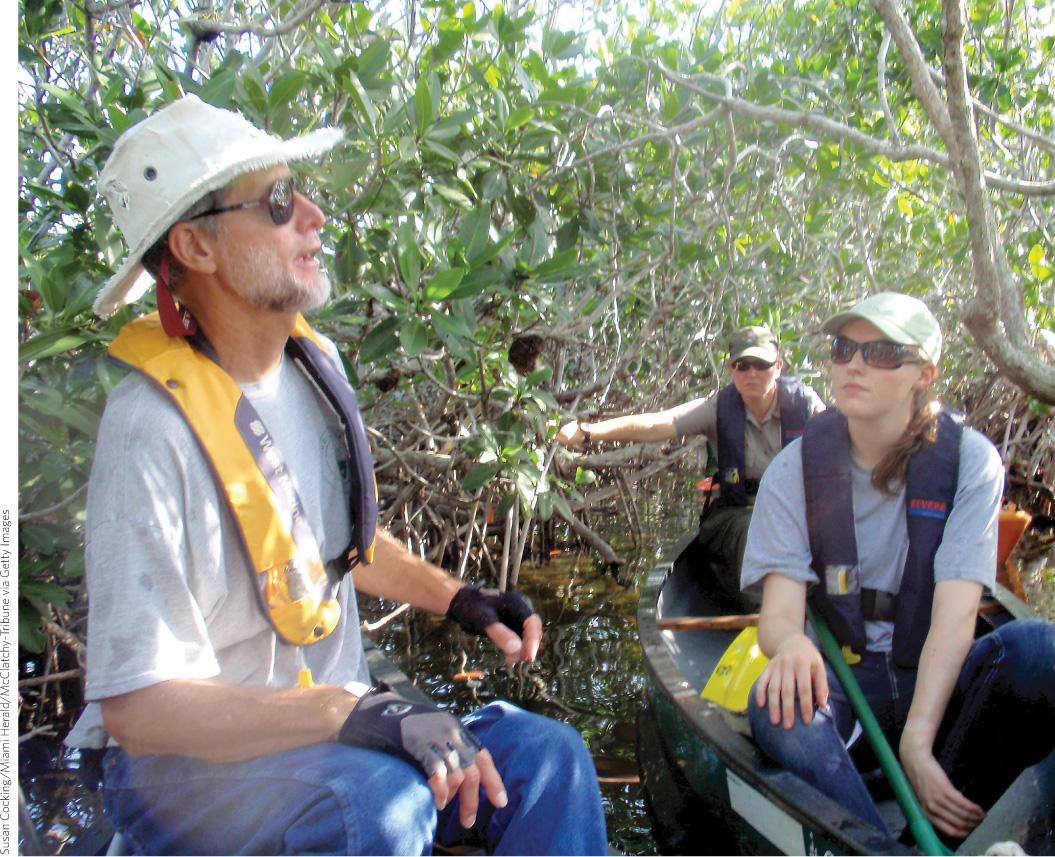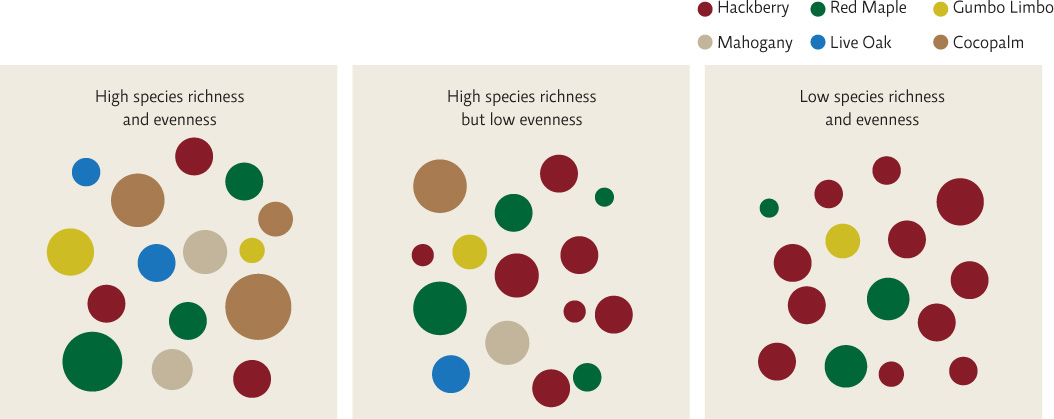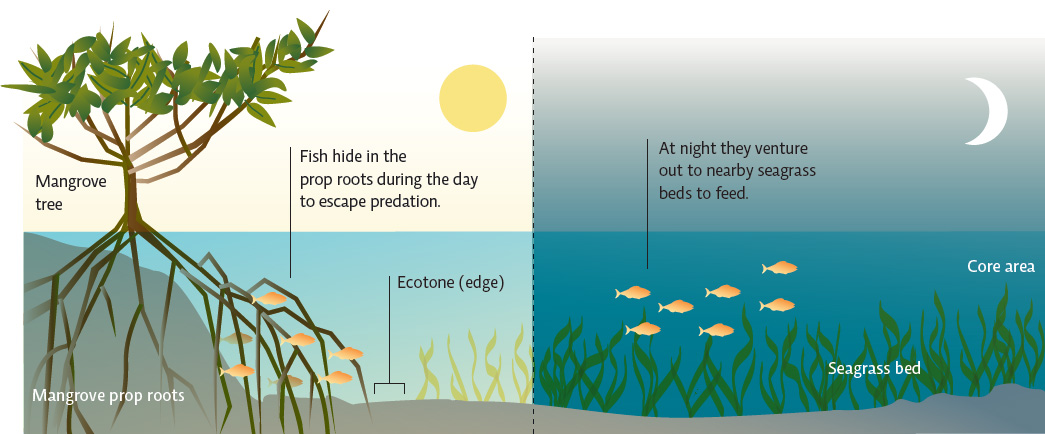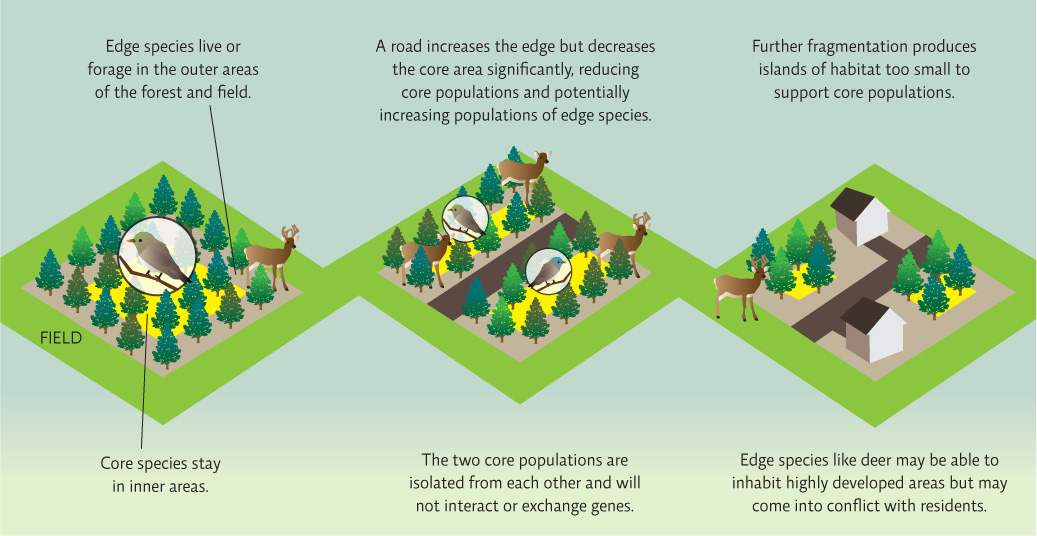Communities, such as the ones found in the Everglades, are shaped by biotic and abiotic factors.
Much of Florida is made up of low, flat land that floods from June through September. During this period, Florida typically receives about 75% of its annual rainfall; water forms a vast sheet, covering thousands of acres, and small changes in depth can amount to large changes in surface area. Many wetland fish grow and reproduce in this expanding habitat. Then, as rains taper off, water begins to recede. And where they were once spread out, fish become concentrated in small ponds and sloughs (free-flowing channels of water that develop in between sawgrass prairies). Foraging storks follow these receding waters, which ecologists like to call “dry down,” from upland ponds to lowland coastal areas, feeding on fish. They are so dependent on this water cycle, studies show, that their breeding cycle is regulated by water levels. Such profound connectedness—between landscape and life—is common in the Everglades.
184

Such connections among species, and between species and their environment, give rise to ecosystem diversity, a measure of the number of species at each trophic level, as well as the total number of trophic levels and available niches. (See Chapter 12 for more on ecosystem diversity.) Each species occupies a unique niche—that is, a unique role and set of interactions in the community, how it gets its energy and nutrients, and its preferred habitat. If two different species tried to occupy exactly the same niche, one would outcompete the other. The less successful species has three choices: Leave the area, switch niches, or die out. Greater ecosystem diversity means more niches and thus more ways for matter and energy to be accessed and exchanged. This generally increases a community’s resilience—its ability to adjust to changes in the environment and return to its original state rather quickly.
niche
The role a species plays in its community, including how it gets its energy and nutrients, what habitat requirements it has, and which other species and parts of the ecosystem it interacts with.
resilience
The ability of an ecosystem to recover when it is damaged or perturbed.
Species diversity, which refers to the variety of species in an area, is measured in two different ways: species richness and species evenness. Species richness refers to the total number of different species in a community. Species evenness refers to the relative abundance of each individual species. In general, organisms at a higher trophic level will have fewer members than those at a lower trophic level, but organisms within the same trophic level should have relatively similar numbers. If they do, the community is said to have high species evenness. If, on the other hand, one or two species dominate any given trophic level, and there are few members of other species, then the community is said to have low species evenness. In such uneven communities, the less abundant species is at greater risk of dying out.
species diversity
The variety of species in an area; includes measures of species richness and evenness.
species richness
The total number of different species in a community.
species evenness
The relative abundance of each species in a community.
185
Both richness and evenness have an impact on diversity. In general, higher species richness and evenness makes for a more diverse community and a more intricate food web. Greater intricacy enables more matter and energy to be brought into the system and also makes the community less likely to collapse in the face of calamity. INFOGRAPHIC 10.3
SPECIES DIVERSITY INCLUDES RICHNESS AND EVENNESS
The species diversity in an area is a measure of species richness (the total number of species) and species evenness (a comparison of the population size of each species). The Everglades contains forested areas known as hardwood hammocks. Each forest plot shown here contains 15 trees, but they differ in terms of species richness and evenness.


Which forest plot shown here would likely have the highest species diversity (richness and evenness) of birds? Explain.
The plot with high tree species richness and evenness would probably contain the most species of birds. The variety of tree species (richness) provides habitat and niches for more bird species than the other plots and the even distribution of the trees (evenness) spreads out the bird species so that they too, have a higher species evenness. In addition, the plot with high richness but low evenness would also be likely to limit bird species richness if species of birds that might occupy a niche provided by a live oak or gumbo limbo tree needed more than one tree in an area this size.
KEY CONCEPT 10.5
Community composition is affected by the physical structure of the habitat, with some species preferring to inhabit ecotone regions where one habitat meets another (the edge) and others staying deep within one habitat (the core).
A community’s composition and diversity is also heavily influenced by its physical features. As physical features like temperature and moisture change, so does community composition. This often happens in ecotones, places where two different ecosystems meet—like the edge between a forest and field or river and shore. The different physical makeup of these edges creates different conditions, known as edge effects, which either attract or repel certain species. For example, it is drier, warmer, and more open at the edge between a forest and field than it is further into the forest. This difference produces conditions favorable to some species but not others. Ecotones may also attract some species that use different aspects of the two adjacent communities; fish such as young snapper or grunts, for example, prefer to live in areas where seagrass beds are fairly close to a shoreline populated by mangrove trees. The mangrove “prop” roots, which anchor the trees into the wet, sandy ground below, offer the fish safety from predators during the day but are close enough to the seagrass beds where the snapper and grunts feed at night for easy “commuting.” These fish are not found in coastal areas without the combination of protective coastal mangrove trees and close-by, offshore seagrass beds. INFOGRAPHIC 10.4
ecotones
Regions of distinctly different physical areas that serve as boundaries between different communities.
edge effects
The different physical makeup of an ecotone that creates different conditions that either attract or repel certain species (e.g., it is drier, warmer, and more open at the edge of a forest and field than it is further in the forest).
MANGROVE EDGES
The mangrove-seagrass ecotone provides an example of an edge effect. Fish such as immature gray snapper and bluestriped grunt “commute” between the mangrove trees and the seagrass beds. The proximity of these two areas is vital to provide both the protection during the day and feeding opportunities at night that these young fish need.


Many coastal mangrove areas are being fragmented as stretches of mangrove are removed for residential or commercial development. What might happen to the gray snapper and bluestriped grunt populations if the mangrove trees are removed from part of the shoreline? What impact would this have on the seagrass beds?
The snapper and grunt populations would shrink as the young fish lose mangrove edges that protect them. They may leave altogether if enough mangrove edge is lost. The seagrass could increase in extent and density without the grazing action of the fish unless other foragers increase in number or move in.
186
Species that thrive in edge habitats like this are called edge species. Other species, those that can only be found deep within the core of a given habitat, are called core species. Some of the many species that find food and refuge in the seagrass, such as crustaceans, sea urchins, and worms, prefer to stay in core areas, where they are better hidden and protected from wave action or can make use of deeper sediment buildup in these inner areas. This fragmentation scenario plays out in ecosystems around the world, especially terrestrial ones such as forests where urban/suburban, agricultural, and industrial development creates patchworks of formerly expansive habitats. Edge species may thrive in these patchy habitats, but because core species will not venture out across the edge in search of new habitat, they are easily trapped by habitat fragmentation; we may eliminate these core species altogether if we don’t leave enough core area behind. (See Chapter 12 for more on habitat fragmentation and core species.) INFOGRAPHIC 10.5
edge species
Species that prefer to live close to the edges of two different habitats (ecotone areas).
core species
Species that prefer core areas of a habitat— areas deep within the habitat, away from the edge.
EDGE EFFECTS
Habitat structure influences where species live. Edge species, like deer, prefer habitats with forest and field edges, whereas core species, like some warblers (small birds), prefer the inner areas of forest and do not readily venture into edge regions.


Why might a wooded corridor that connects two habitat fragments need to be wider for a warbler than for a deer if we expect the bird to use it to travel between fragments?
The corridor must be wide enough to provide core area for the bird. If it is too narrow, it will provide nothing but edge habitat and the bird will not use it.